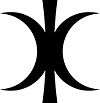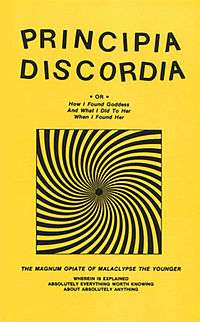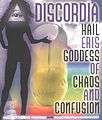Discordianism
Discordianism is a religion and subsequent philosophy based on the veneration or worship of Eris, a.k.a. Discordia, the Goddess of chaos, or archetypes or ideals associated with her. It was founded after the 1963 publication of its holy book, the Principia Discordia,[1] written by Greg Hill with Kerry Wendell Thornley, the two working under the pseudonyms Malaclypse the Younger and Omar Khayyam Ravenhurst.
The religion has been likened to Zen based on similarities with absurdist interpretations of the Rinzai school, as well as Taoist philosophy. Discordianism is centered on the idea that both order and disorder are illusions imposed on the universe by the human nervous system, and that neither of these illusions of apparent order and disorder is any more accurate or objectively true than the other.
There is some division as to whether it should be regarded as a parody religion, and if so, to what degree.[2] It is difficult to estimate the number of Discordians because they are not required to hold Discordianism as their only belief system,[3] and because there is an encouragement to form schisms and cabals.[4][5]
Founding and structure
The foundational document of Discordianism is the Principia Discordia, fourth edition, written by Malaclypse the Younger, an alias of Greg Hill. This book contains many references to an earlier source, The Honest Book of Truth (HBT). From the quotations, the HBT seems to be arranged like the Bible, consisting of verses grouped into chapters grouped into books grouped into the HBT itself. The Principia includes a large portion (or possibly all) of a chapter of "The Book of Explanations" which recounts how the HBT was revealed to Lord Omar Khayyam Ravenhurst. The tale of the discovery of the HBT contains many similarities to the tale of the discovery of the Book of Mormon, and Ravenhurst had been a Mormon. It also includes part of the next chapter, telling how the HBT was taken by a garbage collector, who refused to return it.
The Principia Discordia often hints that Discordianism was founded as a dialectic antithesis to more popular religions based on order, although the rhetoric throughout the book describes chaos as a much more underlying impulse of the universe. This may have been done with the intention of merely "balancing out" the creative forces of order and disorder, but the focus is on the more disorderly aspects of the world — at times the forces of order are even vilified. There are other religions that revere the principles of harmony and order in the Universe, but few that show a respect for the disorder which we all face.[6][7]
The very idea of a Discordian organization is something of a paradox. Nevertheless, some structure is indicated in Principia Discordia. The most general group, presumably including all Discordians (and potentially others), is The Discordian Society, whose definition is "The Discordian Society has no definition". Within the society are sects of Discordianism, each under the direction of an "Episkopos" (overseer or bishop in Koine Greek, the same word used in the New Testament for Christian Bishops).
Mythology
Eris and Aneris
In discordian mythology, Aneris is described as the sister of Eris aka Discordia. Whereas Eris/Discordia is the Goddess of Disorder and Being, Aneris/Harmonia is the Goddess of Order and Non-Being.
"DOGMA III – HISTORY 32, 'COSMOGONY'" in Principia Discordia, states
- In the beginning there was VOID, who had two daughters; one (the smaller) was that of BEING, named ERIS, and one (the larger) was of NON-BEING, named ANERIS.[8]
The sterile Aneris becomes jealous of Eris (who was born pregnant), and starts making existent things non-existent. This explains why life begins, and later ends in death.
- And to this day, things appear and disappear in this very manner.[8]
The names of Eris and Aneris (who are later given a brother, Spirituality), are used to show some fundamental Discordian principles in "Psycho-Metaphysics":
- The Aneristic Principle is that of APPARENT ORDER; the Eristic Principle is that of APPARENT DISORDER. Both order and disorder are man made concepts and are artificial divisions of PURE CHAOS, which is a level deeper than is the level of distinction making.[9]
Hand of Eris

The Five-Fingered Hand of Eris (also known as The Hand of Eris or, within a discordian context, simply The Hand) is the name given to "two opposing arrows converging into a common point". The "canonical" example is shown at right, but the passage quoted goes on to say: "It may be vertical, horizontal or else such, and it may be elaborated or simplified as desired". Eris is the Greek goddess of strife and discord.
The concepts represented by The Hand are of considerable importance to Discordians, but due to the simplicity of the symbol and the widespread applications of its meaning, The Hand appears in many other contexts as well, albeit often without awareness or implication of Discordian connections.[10]

A particular form of The Hand (shown at right) has been proposed for use as the astronomical and astrological symbol for the dwarf planet Eris.[11] This form of The Hand and other proposed symbols are used informally in certain circles; however, it is unlikely that Eris will be assigned an official symbol by the IAU, since graphical symbols are rarely assigned to minor objects in modern times.[12]
The Hand is one of several symbols sometimes used to designate the conclusion of a mathematical proof by contradiction. In this setting, it is usually drawn horizontally, with little or no adornment, as , , or some minor variant thereof. While less compact than some of the alternatives (such as the blitz or crosshatch), The Hand has the advantage of being visually suggestive of the core concept of this method of reasoning: The conflicting conclusions are represented by the two arrows, and in order to avoid an impasse, one set of assumptions must give way.
The Original Snub
The Original Snub is the Discordian name for the events preceding the Judgement of Paris, although more focus is put on the actions of Eris. Zeus believes that Eris is a troublemaker, so he does not invite her to Peleus and Thetis's wedding. This is "The Doctrine of the Original Snub".
Having been snubbed, Eris creates a golden apple with the word kallisti (Ancient Greek: καλλίστῃ, to the prettiest one) inscribed in it. This, the Apple of Discord, is a notable symbol in Discordianism for its inclusion in the Holy Chao. The apple is traditionally described as being made of gold,[13] but the Principia Discordia notes a debate over whether the "gold" described was "metallic gold or Acapulco." Because of the original snub "a Discordian is to partake of No Hot Dog Buns" (Buns being snub backwards). When the female wedding guests disagree about who the apple is meant for, Zeus decides to leave the decision to Paris of Troy. Aphrodite bribes Paris, leading to the Trojan War, which "is said to be The First War among men."
Some recent interpretations of the Original Snub place Eris as being not at all mischievous with her delivery of the apple, but instead suggest that Eris was simply bringing the apple as a wedding present for Thetis. This interpretation would see Eris as innocent and her causing of chaos as a by-product of the other wedding guests' reaction upon seeing her at the wedding.[14][15] However, other interpretations consider this to be a fundamental misinterpretation of Discordian doctrine, which focuses, per the name, on the intentional promotion of discord, which is meaningless in some sense since the Chao Te Ching states that the escalation of disorder, and the imposition of order each adds to the other.
Curse of Greyface
A historical figure noted in the Principia is a man by the name of Greyface who existed in the year 1166 BC, or 1 YOLD. Greyface believed the universe to be humorless and began teaching that anything besides seriousness was sinful. Deluding society's view of reality away from the happy romance they once knew it to be, Greyface's followers increased. Lost in the history of the Discordian society is understanding of the reason why people began following Greyface and the destruction of other cultures whose societies differed from their own, rather than continuing to look toward the humorful romance of disorder.
Philosophy
Three core principles
The Principia Discordia holds three core principles: the Aneristic Principle (order), the Eristic Principle (disorder) and the notion that both are mere illusions. The following excerpt summarizes these principles:
The Aneristic Principle is that of apparent order; the Eristic Principle is that of apparent disorder. Both order and disorder are man made concepts and are artificial divisions of pure chaos, which is a level deeper than is the level of distinction making.With our concept-making apparatus called "the brain" we look at reality through the ideas-about-reality which our cultures give us. The ideas-about-reality are mistakenly labeled "reality" and unenlightened people are forever perplexed by the fact that other people, especially other cultures, see "reality" differently.
It is only the ideas-about-reality which differ. Real (capital-T) True reality is a level deeper than is the level of concept. We look at the world through windows on which have been drawn grids (concepts). Different philosophies use different grids. A culture is a group of people with rather similar grids. Through a window we view chaos, and relate it to the points on our grid, and thereby understand it. The order is in the grid. That is the Aneristic Principle.
Western philosophy is traditionally concerned with contrasting one grid with another grid, and amending grids in hopes of finding a perfect one that will account for all reality and will, hence, (say unenlightened westerners) be true. This is illusory; it is what we Erisians call the Aneristic Illusion. Some grids can be more useful than others, some more beautiful than others, some more pleasant than others, etc., but none can be more True than any other.
Disorder is simply unrelated information viewed through some particular grid. But, like "relation", no-relation is a concept. Male, like female, is an idea about sex. To say that male-ness is "absence of female-ness", or vice versa, is a matter of definition and metaphysically arbitrary. The artificial concept of no-relation is the Eristic Principle.
The belief that "order is true" and disorder is false or somehow wrong, is the Aneristic Illusion. To say the same of disorder, is the Eristic Illusion. The point is that (little-t) truth is a matter of definition relative to the grid one is using at the moment, and that (capital-T) Truth, metaphysical reality, is irrelevant to grids entirely. Pick a grid, and through it some chaos appears ordered and some appears disordered. Pick another grid, and the same chaos will appear differently ordered and disordered.
—Malaclypse the Younger, Principia Discordia, Pages 00049–00050
The Pentabarf
The Pentabarf are 5 rules of Discordianism. As venerators of Eris, Discordian views vary from one person to the next as neither order or disorder, nor chaos are requisites of falling into the Discordian category. The fifth rule is representative of that.
- There is no Goddess but Goddess and She is Your Goddess. There is no Erisian Movement but The Erisian Movement and it is The Erisian Movement. And every Golden Apple Corps is the beloved home of a Golden Worm.
- A Discordian Shall Always use the Official Discordian Document Numbering System.
- A Discordian is Required during his early Illumination to Go Off Alone & Partake Joyously of a Hot Dog on a Friday; this Devotive Ceremony to Remonstrate against the popular Paganisms of the Day: of Catholic Christendom (no meat on Friday), of Judaism (no meat of Pork), of Hindic Peoples (no meat of Beef), of Buddhists (no meat of animal), and of Discordians (No Hot Dog Buns).
- A Discordian shall Partake of No Hot Dog Buns, for Such was the Solace of Our Goddess when She was Confronted with The Original Snub.
- A Discordian is Prohibited of Believing What he Reads.
Order and Disorder
Discordians hold three core principles. The Aneristic Principle is that of apparent order, the Eristic Principle is that of apparent disorder, and the notion that both are mere illusions. Order and disorder are man-made concepts and are artificial divisions of "pure chaos" may be compared to the noumenon described by Plato and Kant.
Sri Syadasti
The third "apostle of Eris & who they be's" name, commonly called just Sri Syadasti, is Sanskrit, and means: All affirmations are true in some sense, false in some sense, meaningless in some sense, true and false in some sense, true and meaningless in some sense, false and meaningless in some sense, and true and false and meaningless in some sense.
The Sacred Chao

A unique symbol created in Discordianism, the Sacred Chao was devised by the Apostle Hung Mung in ancient China. It is a modified version of the Yin-Yang, a common symbol in Taoism. The Sacred Chao is not the Yin-Yang of the Taoists. On one side of the Sacred Chao is a pentagon and on the other depicts the golden Apple of Discord. The Sacred Chao symbolizes absolutely everything anyone would need to ever know about absolutely anything, and more. It even symbolizes everything not worth knowing, depicted by the internal empty space surrounding.
It should be noted that Discordians pronounce "chao" as "cow",[16] thus making the terms "Sacred Chao", "Holy Chao", and "Chao Te Ching" into puns and inside jokes. A Chao represents one unit of Chaos.
Operation Mindfuck
Operation Mindfuck or OM is an important practice in the Discordian religion. The concept was developed by Kerry Thornley and Robert Anton Wilson in 1968[17] and given its name by Wilson and Robert Shea in The Illuminatus! Trilogy.[18] It is most often manifested as a decentralized campaign of civil disobedience, activism, art movements, especially performance art and guerrilla art, culture jamming, graffiti and other vandalism, practical jokes, hoaxes, reality hacking, chaos magic, words of power, and anything else that is believed to bring about social change through disrupting paradigms and thus forcing the victim to question the parameters of his or her reality tunnel. There is a disagreement among Discordians as to whether or not, through OM, they should seek to improve society, topple it or claim that the practice is in fact only for entertainment. Because much of Operation Mindfuck itself involves hyperbole and exaggeration in regard to discussing the Discordian Society, it is difficult to determine the actual scale of the campaign, be it large or practically non-existent.
In The Illuminatus! Trilogy and its sequels, Operation Mindfuck is epitomized by a protagonist named Markoff Chaney, an anti-social dwarf who engages in subtle practical joking, in a deliberate attempt to cause Discord, as a protest against his mistreatment by society. One such joke involves the forging of signs that are signed by "The Mgt." (leading people to believe they're from "The Management" instead of "the Midget") that contain absurdities, and placing the signs in stores and other establishments.
There are several projects involved in Operation Mindfuck (as outlined in Appendix Yod of The Illuminatus! Trilogy). These are:
- Project Jake: "Instigated by Harold Lord Randomfactor. Once or twice a year, a public servant who has distinguished himself by more than common imbecility is selected as target for a Jake and all Discordian cabals are alerted." The official being honored receives mail from all the cabals at once on Jake Day. The letters should be printed on the official letterhead of each of the cabals and ask for help in "some complicated political matter that passes all rational understanding."
- Project Eagle: "Day-glo posters have been printed which look like the old Eagle proclamation saying TO THE POLLS YE SONS OF FREEDOM. The new, improved Discordian posters, however, have one slight word change, and say cheerfully BURN THE POLLS YE SONS OF FREEDOM. Like the old ones, they are posted in prominent places on election day."
- Project Pan-Pontification: This project consists of the distribution of "Pope cards" claiming every man, woman, and child on Earth as a Pope of Discord.
- Project Graffito (and Project Bumpersticker): "Anybody can participate by inventing a particularly Erisian slogan and seeing that it is given wide distribution. Examples: Your Local Police Are Armed and Dangerous; Legalize Free-Enterprise Murder; Why Should Governments Have All the Fun?; Smash the Government Postal Monopoly; If Voting Could Change the System, It Would Be Against the Law; etc."
- Citizens Against Drug Abuse: "This organization possesses elegant letterheads and is engaged in a campaign of encouraging Congressmen to outlaw catnip, a drug which some young people are smoking whenever marijuana is in short supply." The idea behind this is that because the government lost much credibility in its war on marijuana, a campaign to outlaw a "similar, but more comical herb" will result in a complete loss of faith in government.
These may not be the only projects in Operation Mindfuck, as a Discordian is encouraged to go out and create their own projects. They are however considered as useful guidelines, hence their inclusion in Illuminatus!.
Writings
Discordian works include a number of books, not all of which actually exist. Among those that have been published are Principia Discordia, first published in 1965 (which includes portions of The Honest Book of Truth); and The Illuminatus! Trilogy, which had its first volume published in 1975.[19]
Principia Discordia
The Principia Discordia is a Discordian religious text written by Greg Hill (Malaclypse the Younger) with Kerry Wendell Thornley (Lord Omar Khayyam Ravenhurst). The first edition was printed using Jim Garrison's Xerox printer in 1963.[20] The second edition was published under the title Principia Discordia or How The West Was Lost in a limited edition of five copies in 1965. The phrase Principia Discordia, reminiscent of Newton's Principia Mathematica, is presumably intended to mean Discordant Principles, or Principles of Discordance.[21]
The Principia describes the Discordian Society and its Goddess Eris, as well as the basics of the POEE denomination of Discordianism. It features typewritten and handwritten text intermixed with clip art, stamps, and seals appropriated from other sources.
While the Principia is full of literal contradictions and unusual humor, it contains several passages which propose that there is serious intent behind the work, for example a message scrawled on page 00075: "If you think the PRINCIPIA is just a ha-ha, then go read it again."
The Principia is quoted extensively in and shares many themes with the satirical science fiction book The Illuminatus! Trilogy by Robert Shea and Robert Anton Wilson. Wilson was not directly involved in writing the Principia.

Notable symbols in the book include the Apple of Discord, the pentagon, and the "Sacred Chao", which resembles the Taijitu of Taoism, but the two principles depicted are "Hodge" and "Podge" rather than yin and yang, and they are represented by the apple and the pentagon, and not by dots. Saints identified include Emperor Norton, Yossarian, Don Quixote, and Bokonon. The Principia also introduces the mysterious word fnord, later popularized in The Illuminatus! Trilogy; the trilogy itself is mentioned in the afterword to the Loompanics edition, and in the various introductions to the fifth editions.


The Principia Discordia or How The West Was Lost was first published in a limited edition of five copies and released into the public domain in 1965.[22] The full title of the fourth and most well-known edition is Principia Discordia or How I Found Goddess And What I Did To Her When I Found Her: The Magnum Opiate Of Malaclypse The Younger, Wherein is Explained Absolutely Everything Worth Knowing About Absolutely Anything. Included on page 00075 is the following note about the history of the Principia:
- This being the 4th Edition, March 1970, San Francisco; a revision of the 3rd Edition of 500 copies, whomped together in Tampa 1969; which revised the 2nd Edition of 100 copies from Los Angeles 1969; which was a revision of PRINCIPIA Discordia or HOW THE WEST WAS LOST published in New Orleans in 1965 in five copies, which were mostly lost.
Additionally, the "contents of this edition" note in the Loompanics edition identifies the fourth edition as having originally been published by Rip Off Press of San Francisco, California. A "Fifth Edition" consisting of a single Western Union telegram page filled with the letter M was published as an appendix to the Loompanics and SJ Games re-printings of the 4th Edition. Reprints of the Fourth and Fifth Editions include:
- Revisionist Press published a red hardcover of the Fourth Edition in 1976, adding a stamp reading "THIS WORK IS A BRIDGE SO MOVE ON THRU" to the right of the golden apple on page 00075. (ISBN 0-685-75085-X)
- Loompanics Unlimited published a version (the "yellow cover version") in 1979, adding an introduction by Robert Anton Wilson, an afterword by Malaclypse the Younger, and the aforementioned "Fifth Edition". (ISBN 1-55950-040-9) This version is reprinted by Paladin Press under ISBN 1-58160-547-1.
- Steve Jackson Games published a version (the "black cover version") in 1994, adding an introduction by Steve Jackson and 20 pages of new Discordian text, mostly collected from online Discordians. (ISBN 1-55634-320-5) Steve Jackson Games also publishes Discordian and Illuminati-inspired games, such as GURPS Illuminati and the Illuminati card game.
- Ronin Publishing released a completely re-edited version in 2006 (ISBN 1-57951-029-9), under the title Discordia - Hail the Goddess of Chaos and Confusion. This edition features a co-credit on the cover for both Malaclypse and Ravenhurst, a colour cover, numerous typographical errors, and is 192 pages in length. Most of the original artwork was replaced with low-quality clip-art.
 NARA Cover sheet for the alleged First Edition
NARA Cover sheet for the alleged First Edition "Yellow cover"
"Yellow cover"
Loompanics Unltd, 1979 "Pink" or "Purple cover"
"Pink" or "Purple cover"
IllumiNet Press, 1991 "Black cover"
"Black cover"
SJ Games, 1994 Discordia: Hail Eris Goddess of Chaos and Confusion
Discordia: Hail Eris Goddess of Chaos and Confusion
Ronin Press, 2006 "Snake cover"
"Snake cover"
Synaptyclypse Generator, 2007
In 1978, a copy of a work from Kerry Thornley titled "THE PRINCIPIA Discordia or HOW THE WEST WAS LOST" was placed in the HSCA JFK collections as document 010857.[23] Adam Gorightly, author of The Prankster and the Conspiracy about Kerry Thornley and the early Discordians, said the copy in the JFK collection was not a copy of the first edition but a later and altered version containing some of the original material. In an interview with researcher Brenton Clutterbuck,[24] Gorightly said he had been given Greg Hill's copy of the first edition. This appeared in its entirety in Historia Discordia, a book on Discordian history released in spring of 2014.[25][26]
The Principia includes a notice which purports to disclaim any copyright in relation to the work: "Ⓚ All Rites Reversed – reprint what you like." Regardless of the legal effect of this notice, the Principia has been widely disseminated in the public domain via the Internet and more traditional print publishers. Some re-publishers have claimed copyright in relation to the additional material included in their editions.
The Illuminatus! Trilogy
One of the most influential of all Discordian works, The Illuminatus! Trilogy is a series of three novels written by Robert Shea and Robert Anton Wilson purportedly between 1969 and 1971,[27] and first published in 1975. The trilogy is a satirical, postmodern, science fiction-influenced adventure story; a drug-, sex- and magic-laden trek through a number of conspiracy theories, both historical and imaginary, which hinge on the authors' version of the Illuminati. The narrative often switches between third and first person perspectives and jumps around in time. It is thematically dense, covering topics like counterculture, numerology and Discordianism.
In a 1980 interview given to the science fiction magazine Starship, Wilson suggested the novel was an attempt to build a myth around Discordianism:
We felt the Discordian Society needed some opposition, because the whole idea of it is based on conflict and dialectics. So, we created an opposition within the Discordian Society, which we called the Bavarian Illuminati [...] So, we built up this myth about the warfare between the Discordian Society and the Illuminati for quite a while, until one day Bob Shea said to me, "You know, we could write a novel about this!"[28]
Zen Without Zen Masters
Zen Without Zen Masters is a book by Camden Benares (The Count of Five), published in 1977, of koans, stories and exercises of a Discordian nature. It includes tales of several early Discordians including Hill (as Mal) and Thornley (as Omar and Ho Chi Zen). "Enlightenment of a Seeker" from this book is also present in Principia Discordia as "A Zen Story".[29] There are references to this story in The Illuminatus! Trilogy, as well.
Zenarchy
Zenarchy was first self-published by Thornley, under the pen name Ho Chi Zen, as a series of one-page (or broadsheet) newsletters in the 1960s,.[30] A selection of the material was later reedited and expanded by Thornley and republished in paperback by IllumiNet Press in 1991. The book describes Thornley's concept of Zenarchy "a way of Zen applied to social life. A non-combative, non-participatory, no-politics approach to anarchy intended to get the serious student thinking." [31]
Summa Universalia
Summa Universalia was another work by Malaclypse the Younger, purported to be a summary of the Universe. It was excerpted in the first edition of Principia but never published. It was mentioned in an introduction to one of the Principia editions, and the work was quoted from in the first edition.[32][33]
The longest known fragment of the text is the Myth of Ichabod (alluded to as the "Myth of Starbuck" in the 4th edition of the Principia) which was circulated independently.
The Honest Book of Truth
In addition to Summa Universalia, Principia Discordia also included selections from Kerry Wendell Thornley's writings, which he named The Honest Book of Truth. These sections are clearly marked, and are subtitled in parody of the bible's books.
The Honest Book of Truth was for a long time not available to the general public, but a copy of it was published in Historia Discordia.
Selections from this work can also be found within The Illuminatus! Trilogy.[34]
Apocrypha Discordia
Apocrypha Discordia was compiled by Rev. DrJon Swabey, later known as His Holiness The Rev. DrJon, and published in 2001. Steve Jackson and Reverend Loveshade had previously considered publishing a book by the name suggested by Russel Dalenberg on the usenet group rec.games.board. The book contains material by both original and later Discordians and is illustrated by Pope Phil Wlodarczyk III.
The Black Iron Prison
The Black Iron Prison was an effort to create an updated, modern book that would function as Principia Discordia did when released. The collaborators stated that "while the original Principia Discordia holds important messages and philosophies, we wondered if some of the humor and language might be dated and lost on a younger generation of Discordians. We wanted to crystalize some of our favorite themes from the Principia, those of radical free will and self-emancipation." The goal was to encourage "critical thinking and self awareness" in the reader.[35] The Black Iron Prison has influenced Discordian communities in various parts of the world.
Ek-sen-trik-kuh Discordia: The Tales of Shamlicht
Ek-sen-trik-kuh Discordia: The Tales of Shamlicht by Reverend Loveshade with "foreplay" or foreword by S. John Ross was published in 2012 by Anaphora Literary Press.[36] The controversial book reportedly was inspired by an investigation by the FBI with portions of the book having been previously seized. Ek-sen-trik-kuh Discordia includes blurbs (short reviews of the book) by R. Crumb, Sondra London, Alan Moore, Rev. Ivan Stang, Robert Anton Wilson (who saw an early draft), and others.[37][38] It was listed in January 2013 in both the print and online version of the New York Review of Books.[38] The book was soon pulled from publication after allegations of plagiarism were made on amazon.com and sent to the publisher. An editor denied the claims which did not specify what material was allegedly plagiarized.[36][39]
Historia Discordia
Historia Discordia was compiled by Adam Gorightly with foreword by Robert Anton Wilson.[40] It is a compilation of early Discordian photos, tracts, art collages, and more including works by Discordianism founders Greg Hill (Malaclypse the Younger) and Kerry Thornley (Omar Khayyam Ravenhurst).[41] Among other things, it contains the long-missing The Honest Book of Truth and the first edition of Principia Discordia.[42] It was reviewed on goodreads,com, and features a blurb by famed comic book writer Alan Moore.[41]
Principia Entropius
Principia Entropius is a gathering of material from early Discordian message boards of the 1990's. Brenton Clutterbuck describe the book as "a terrible mess that makes one's head hurt", but also as "a rare and valuable (historically if not creatively) snapshot of Discordianism in the 90s".
See also
References
- ↑ Wilson, Robert Anton (1992). Cosmic Trigger I: Final Secret of the Illuminati. Scottsdale, AZ: New Falcon Publications. p. 65. ISBN 978-1561840038.
- ↑ "...It should on no account be taken seriously but is far more serious than most jokes" and "See ... [also] ha ha only serious" The Jargon File v4.4.7 but present at least as far back as v4.0.0, (1996, July 24); The entry for discordianism begins, "Somewhere between parody, social commentary, and religion..." Rabinovitch, Shelly & Lewis, James R. The Encyclopedia of Modern Witchcraft and Neo-Paganism, pp 75–76. Citadel Press. 2002. ISBN 0-8065-2406-5; "These organisations [Discordianism & The Church of the Subgenius] are just two of a whole raft of mock religions..." Phillips, M. (2004, Sept. 14). Wizards of ID cook up divine pile of spaghetti bolognese. The West Australian, p. Metro 18; "The explosion of the American counter-culture and the revival of surrealism met Discordianism (1960's and 70's) and the result was a Neo-Pagan parody religion of mirth and laughter." (p. 3) E. K. Discorida. (2005). The Book of Eris. Synaptyclypse Generator
- ↑ Rabinovitch, Shelly & Lewis, James. The Encyclopedia of Modern Witchcraft and Neo-Paganism". Pp 75–76. Citadel Press. 2002. ISBN 0-8065-2406-5.
- ↑ "WitchVox Traditions Discordianism Article". Witchvox.com. Archived from the original on 30 September 2007. Retrieved 2009-08-31.
- ↑ "Discordian Cabals – S23Wiki". S23.org. Retrieved 2013-03-26.
- ↑ "World Religions". Worldreligions.psu.edu. Retrieved 2009-08-31.
- ↑ "Design Arguments for the Existence of God [Internet Encyclopedia of Philosophy]". Iep.utm.edu. 2009-04-12. Retrieved 2009-08-31.
- 1 2 "Page 56". Principia Discordia. Retrieved 2012-08-19.
- ↑ "Internet Archive Wayback Machine". Web.archive.org. 2009-10-27. Archived from the original on October 27, 2009. Retrieved 2012-08-19.
- ↑ "The Hand of Eris". Symbol Dictionary. Retrieved 26 November 2016.
- ↑ "ERIS NEEDS A (Planetary) SYMBOL". Discord-society.livejournal.com. Retrieved 17 September 2016.
- ↑ Keiron Le Grice: Discovering Eris: The Symbolism and Significance of a New Planetary Archetype. Edinburgh 2012, ISBN 978-0863158674
- ↑ The Judgement of Paris
- ↑ Scullion, Sean (Nov 26, 2007). Liber Malorum - Children of the Apple. PagAnarchy Press. p. 375. ISBN 978-0955798405.
- ↑ Swiss, Tom (2009). Tom Swiss: Eris and the so-called "Apple of Discord".
- ↑ Ancient Symbols: "Sacred Chao"
- ↑ Gorightly, Adam (2005). "The Prankster or The Manchurian Candidate?". The Beast of Adam Gorightly: Collected Rantings (1992-2004). Virtualbookworm Publishing. p. 163. ISBN 978-1-58939-781-1. Retrieved 2008-12-02.
- ↑ Shea, Robert; Robert Anton Wilson (1976). Illuminatus!. Sphere Books. ISBN 978-0-7221-9208-5. Retrieved 2008-12-02.
- ↑ Cosmic Trigger I: The Final Secret of the Illuminati (1977), page 167. ISBN 1-56184-003-3
- ↑ Wilson, Robert Anton (1992). Cosmic Trigger I: Final Secret of the Illuminati. Scottsdale, AZ: New Falcon Publications. p. 65. ISBN 978-1561840038.
- ↑ In Latin, discordia is not an adjective. It can be a singular noun by itself, meaning "discord", or, like principia, be the plural of a noun – discordium, also meaning "discord". In either case, the phrase consists of two juxtaposed nouns without a grammatical relationship.
- ↑ Frauenfelder, Mark (November 1, 2006). "Publisher alters, then copyrights Principia Discordia". Boing Boing.
- ↑ The record identifier can be found by searching for Thornley and Discordian on nara.gov. "Kennedy Assassination Collection: Discordian Socity [sic]". National Archives and Records Administration. Retrieved 17 February 2012.
- ↑ "Wikinews interviews Brenton Clutterbuck". Wikinews. Retrieved 29 August 2013.
- ↑ "Adam Gorightly presents the COMPLETE first edition Principia Discordia". Retrieved 29 August 2013.
- ↑ Adam Gorightly: "Historia Discordia" (2014). ISBN 1618613219
- ↑ Illuminatus! was written between 1969 and 1971, but not published until 1975 according to Robert Anton Wilson, Cosmic Trigger I: The Final Secret of the Illuminati (1977), page 145. ISBN 1-56184-003-3
- ↑ "Robert Anton Wilson: Searching For Cosmic Intelligence" by Jeffrey Elliot Interview discussing novel . Retrieved 21 February 2006.
- ↑ Camden Benares: Zen Without Zen Masters (1977), pages 40-41. ISBN 978-1-56184-073-1
- ↑ Groover, Joel (1998-12-03). "Kerry Thornley, philosopher, writer, friend of Oswald" (fee required). Atlanta Journal-Constitution. p. F8. Retrieved 2008-03-24.
- ↑ Kerry Thornley, "Zenarchy" (1991), ISBN 0962653411
- ↑ "By no means is the Principia our only scripture. All along Greg has been writing what he says is a summary of the Universe, but evidently it will be quite some time before he completes it." Thornley, Kerry: "Principia Discordia", page ix. Illuminet Press, 1991. As quoted at http://www.cs.cmu.edu/~tilt/principia/intro5.html.
- ↑ Malaclypse and Ravenhurst: Principia Discordia, pages 2, 10, A14."Excerpted from a treatise concerning The Nature of Gods and The Eristesque Movement, to be found in the SUMMA UNIVERSALIA, the Holy Work of MALACLYPSE (THE YOUNGER), K.C., Omniscient Polyfather of Virginity-in-gold, and High Priest of The Heretic Fringe and Protestant Persuasion of the ERISIAN MOVEMENT of the DISCORDIAN SOCIETY " As found at http://appendix.23ae.com/pd1/17.html, http://appendix.23ae.com/pd1/25.html , http://appendix.23ae.com/pd1/14.html .
- ↑ Shea, Robert and Wilson, Robert Anton: The Illuminatus! Trilogy, pages 7, 141, 217, 657. Dell Publishing, 1988
- ↑ http://www.blackironprison.com/index.php?title=Main_Page
- 1 2 "Anaphora Literary Press: Reverend Loveshade". Anaphora Literary Press. 2012. Retrieved 2013-01-24.
- ↑ Loveshade, Reverend (2012). Ek-sen-trik-kuh Discordia: The Tales of Shamlicht. Anaphora Literary Press. ISBN 978-1937536183.
- 1 2 "Independent Press Listing" (PDF). New York Review of Books. 2013-01-10. Retrieved 2013-01-24.
- ↑ "Ek-sen-trik-kuh Discordia". amazon.com. Retrieved 2013-10-26.
- ↑ "Historia Discordia". RVP Press. 2014. Retrieved 2016-07-26.
- 1 2 "Historia Discordia". RVP Press. 2014. Retrieved 2016-07-26.
- ↑ Griffin, Andrew W. (August 6, 2014). "BOOK REVIEW: "Historia Discordia" by Adam Gorightly". Red Dirt Report. Retrieved 2016-07-26.
External links
- PrincipiaDiscordia.com – contains the Principia Discordia in HTML. Also has Discordian message boards and other resources.
- The Semi-Official Quasi-Clandestine Bavarian Illuminati/Discordian Archives An archive of early Discordian documents, photos and paraphernalia.
- Discordian Calendar Calculator
- Discordian Online Library of the M'.'M'.'M'.' A vast collection of various Discordian documents they have collected that are considered important (or not) by the various cabal's/groups/individuals among the Discordian community.
- HyperDiscordia – hypertext Discordian encyclopedia.
- Kristin Buxton's Discordianism site – long-standing Web repository of Discordiana, now via WayBackMachine
- Discordian Saints – 1999 archive from Andrew C. Bulhak.
- The Discordian Saints – compiles 4 lists (Andrew Bulhak as anon.; Pope Icky Fundament, PZK; Tonisoa Postatis; Snorri Abrahamsem)
- Discordian Tarot with 'Reading' – the free deck consists of 73 cards, incl. 23 Trumps (also as PDF, 0.7 MB)
- Legion of Dynamic Discord on Lost Souls Wiki - claims to be a parent organisation.
- Psychedelic Tabby Cabal - WayBack Archive of classic HTML portal to weirdness.

